The Armoured Vehicles of the Reconnaissance Corps.
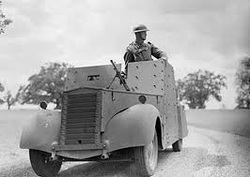
The Beaverette
The first version of the vehicle was built in 1940 by Standard Motor Companyat the instigation of Lord Beaverbrook, then Minister of Aircraft Production(hence the name Beaverette). It was based on commercial car chassis, on which a simple riveted armoured hull was mounted. The 11mm of steel was backed by 3 inch thick oak planks. The hull was open at the top and at the rear. The armament consisted of Bren light machine gun which could be fired through a slot in the glacis armour. Subsequent versions received all-around protection and a machine gun turret - an enclosed one with Bren MG or an open-topped one with twin Vickers machine guns. Some vehicles also carried Boys anti-tank rifles. Some had No. 11 or No. 19 radio set. The production was stopped in 1942. About 2,800 units were delivered.
The Beaverette was used by the British Army and Royal Air Force for home defence service and training. The vehicle is said to have been worn out and suffered from excessive weight and to be hard to handle.
Weight Mk I: 2 tonnes (2.2 short tons; 2.0 long tons)
Mk III: 2.6 tonnes (2.9 short tons; 2.6 long tons) LengthMk I: 4.11 m (13 ft 6 in)
Mk III: 3.10 m (10 ft 2 in) Width Mk I: 1.60 m (5 ft 3 in)
Mk III: 1.73 m (5 ft 8 in) Height Mk I: 1.52 m (5 ft 0 in)
Mk III: 2.16 m (7 ft 1 in) Crew3 ArmourMk III: up to 9 mm (0.35 in)
Mk IV: up to 12 mm (0.47 in)
Main armament 0.303 (7.7 mm) Bren MG or twin Vickers machine gun.
EngineStandard 4-cylinder petrol engine 46 hp (34 kW)Power/weight17-23 hp/tonne
Suspension 4x2 wheel, leaf spring
Operational range Mk III: 300 km (190 mi)
Speed Mk III: 38 km/h (24 mph)
The first version of the vehicle was built in 1940 by Standard Motor Companyat the instigation of Lord Beaverbrook, then Minister of Aircraft Production(hence the name Beaverette). It was based on commercial car chassis, on which a simple riveted armoured hull was mounted. The 11mm of steel was backed by 3 inch thick oak planks. The hull was open at the top and at the rear. The armament consisted of Bren light machine gun which could be fired through a slot in the glacis armour. Subsequent versions received all-around protection and a machine gun turret - an enclosed one with Bren MG or an open-topped one with twin Vickers machine guns. Some vehicles also carried Boys anti-tank rifles. Some had No. 11 or No. 19 radio set. The production was stopped in 1942. About 2,800 units were delivered.
The Beaverette was used by the British Army and Royal Air Force for home defence service and training. The vehicle is said to have been worn out and suffered from excessive weight and to be hard to handle.
Weight Mk I: 2 tonnes (2.2 short tons; 2.0 long tons)
Mk III: 2.6 tonnes (2.9 short tons; 2.6 long tons) LengthMk I: 4.11 m (13 ft 6 in)
Mk III: 3.10 m (10 ft 2 in) Width Mk I: 1.60 m (5 ft 3 in)
Mk III: 1.73 m (5 ft 8 in) Height Mk I: 1.52 m (5 ft 0 in)
Mk III: 2.16 m (7 ft 1 in) Crew3 ArmourMk III: up to 9 mm (0.35 in)
Mk IV: up to 12 mm (0.47 in)
Main armament 0.303 (7.7 mm) Bren MG or twin Vickers machine gun.
EngineStandard 4-cylinder petrol engine 46 hp (34 kW)Power/weight17-23 hp/tonne
Suspension 4x2 wheel, leaf spring
Operational range Mk III: 300 km (190 mi)
Speed Mk III: 38 km/h (24 mph)
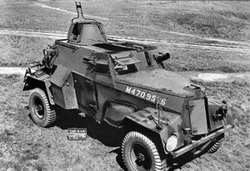
The Humber Light Reconnaissance Car, also known as Humberette or Ironside, was a British armoured car produced during the Second World War.
Produced by the Rootes Group, the Humber Light Reconnaissance Car was an armoured car based on the Humber Super Snipe chassis (as was the 4x4 Humber Heavy Utility car). It was equipped with a No. 19 radio set. From 1940 to 1943 over 3600 units were built.
The vehicle was used by Infantry Reconnaissance Regiments and the RAF Regiment in Tunisia, Italy and Western Europe. After the war, some vehicles remained in service with the British units in India and in the Far East. The LRC was used widely by the Reconnaissance Corps and was also used by the Reconnaissance squadron of the 1st Czechoslovak Independent Armoured Brigade Group.
Three Mk I vehicles were modified for use by the British Royal Family and theCabinet ministers and were known as Special Ironside Saloons.
Manufacturer Humber (Rootes Group)
Number built more than 2,400
Specifications (Mark II)
Weight 3.17 tons
Length 14 ft 4 in (4.37 m)
Width 6 ft 2 in (1.88 m)
Height 6 ft 11 in (2.11 m)
Crew 3
Armour up to 12 mm
Main armament Boys anti-tank rifle
Secondary armament 0.303 in (7.7 mm) Bren light machine gun
Smoke discharger
Engine 4.1 L 6-cylinder inline sidevalve petrol engine
80-87 hp (60-65 kW)
Power/weight 29 hp/tonne
Suspension 4 x 2 wheel
Operational range 110 mi (180 km)
Speed 75 mph (121 km/h) on road
Produced by the Rootes Group, the Humber Light Reconnaissance Car was an armoured car based on the Humber Super Snipe chassis (as was the 4x4 Humber Heavy Utility car). It was equipped with a No. 19 radio set. From 1940 to 1943 over 3600 units were built.
The vehicle was used by Infantry Reconnaissance Regiments and the RAF Regiment in Tunisia, Italy and Western Europe. After the war, some vehicles remained in service with the British units in India and in the Far East. The LRC was used widely by the Reconnaissance Corps and was also used by the Reconnaissance squadron of the 1st Czechoslovak Independent Armoured Brigade Group.
Three Mk I vehicles were modified for use by the British Royal Family and theCabinet ministers and were known as Special Ironside Saloons.
Manufacturer Humber (Rootes Group)
Number built more than 2,400
Specifications (Mark II)
Weight 3.17 tons
Length 14 ft 4 in (4.37 m)
Width 6 ft 2 in (1.88 m)
Height 6 ft 11 in (2.11 m)
Crew 3
Armour up to 12 mm
Main armament Boys anti-tank rifle
Secondary armament 0.303 in (7.7 mm) Bren light machine gun
Smoke discharger
Engine 4.1 L 6-cylinder inline sidevalve petrol engine
80-87 hp (60-65 kW)
Power/weight 29 hp/tonne
Suspension 4 x 2 wheel
Operational range 110 mi (180 km)
Speed 75 mph (121 km/h) on road
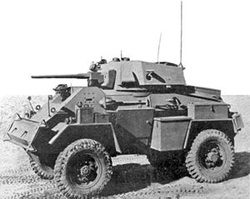
Humber Heavy Armoured Car
Made by the Rootes Group, the Humber was essentially a combination of the Karrier KT 4 artillery tractor chassis and the armoured body of the Guy Armoured Car. The KT4 was already in production for the Indian Army, and Guy were having problems with the production levels required. The Karrier name was dropped to avoid confusion.
The first order for 500 was placed in 1940. The first Humbers were more or less identical to the Guy down to the faults in armour but this was rectified. Production started in 1941.
The Mark III improved upon the Mark II by providing a three-man turret. Mark III production ended in 1942 after 1,650 had been built. With a possible replacement, the 2-pounder armed Coventry armoured car, on its way, the Mark IV was designed. This put the US 37 mm gun in the turret but at the cost of one crewman. The Coventry was not ordered as a replacement and so production of Mark IV continued, for a total of 2,000, despite its flaws.
Manufacturer Rootes Group (Karrier)
Number built 5,400
Weight 5 t
Length15 ft 1.5 in (4.610 m) Width7 ft 3 in (2.21 m) Height7 ft 10 in (2.39 m)
Crew Mk I, II, IV: 3
Mk III: 4Armour15 mm.
Main armament Mk I-III: 15 mm Besa machine gun Mk IV: US made M5 or M6 37 mm gun
Secondary armament 7.92 mm Besa machine gun
EngineRootes 6 cyl petrol engine 90 hp (67 kW) Power/weight 12.9 hp/tonne
SuspensionWheel 4x4, rigid front and rear axles, rear-wheel drive with selectable four-wheel drive.
Operational range 200 mi (320 km)
Speed50 mph (80 km/h)
Made by the Rootes Group, the Humber was essentially a combination of the Karrier KT 4 artillery tractor chassis and the armoured body of the Guy Armoured Car. The KT4 was already in production for the Indian Army, and Guy were having problems with the production levels required. The Karrier name was dropped to avoid confusion.
The first order for 500 was placed in 1940. The first Humbers were more or less identical to the Guy down to the faults in armour but this was rectified. Production started in 1941.
The Mark III improved upon the Mark II by providing a three-man turret. Mark III production ended in 1942 after 1,650 had been built. With a possible replacement, the 2-pounder armed Coventry armoured car, on its way, the Mark IV was designed. This put the US 37 mm gun in the turret but at the cost of one crewman. The Coventry was not ordered as a replacement and so production of Mark IV continued, for a total of 2,000, despite its flaws.
Manufacturer Rootes Group (Karrier)
Number built 5,400
Weight 5 t
Length15 ft 1.5 in (4.610 m) Width7 ft 3 in (2.21 m) Height7 ft 10 in (2.39 m)
Crew Mk I, II, IV: 3
Mk III: 4Armour15 mm.
Main armament Mk I-III: 15 mm Besa machine gun Mk IV: US made M5 or M6 37 mm gun
Secondary armament 7.92 mm Besa machine gun
EngineRootes 6 cyl petrol engine 90 hp (67 kW) Power/weight 12.9 hp/tonne
SuspensionWheel 4x4, rigid front and rear axles, rear-wheel drive with selectable four-wheel drive.
Operational range 200 mi (320 km)
Speed50 mph (80 km/h)
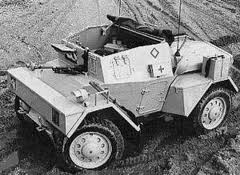
Daimler Dingo
In 1938 the British War Officeissued a specification for a scouting vehicle. Three British motor manufacturers: Alvis, BSA Cycles and Morris were invited to supply prototypes. Alvis had been in partnership with Nicholas Straussler and provided armoured cars to the Royal Air Force, Morris had participated in trials and production of armoured cars, and BSA Cycles -whose parent Birmingham Small Arms (BSA) was involved in armaments - had a small front wheel drive vehicle in production.
Testing began in August 1938. All were of similar size and layout - rear engine and all four wheels driven. The Morris design was eliminated first - suffering from poor speed even after modification by its builders. The Alvis prototype - known as "Dingo" - could manage 50 mph over a cross country course but had a high centre of gravity. The BSA prototype was completed in September and handed over for testing. By December it had covered 10,000 miles on- and off-road with few mechanical problems. Policy from the War Office changed to a requirement for better armour with the effect that an armoured roof was needed. As a consequence the BSA vehicle needed a more powerful engine and strengthened suspension. It was chosen over the Alvis and the first order (172 vehicles) for the "Car, Scout, Mark I" was placed in May 1939.
The actual production was passed to Daimler, which was a vehicle manufacturer in the BSA group of companies. The design was seen to have potential and served as the basis for the development of a larger armoured car - a "Light Tank (Wheeled)". Design work on what would become the Daimler Armoured Car began in April 1939 and the first pilot built by the end of the year.
The vehicle was later officially designated Daimler Scout Car, but became widely known by the name of Alvis's design - "Dingo".
Arguably one of the finest armoured fighting vehicles built in Britain during the war, the Dingo was a small two-man armoured car. It was well protected for its size with 30 mm of armour at the front. The 2.5 litre 55 hp engine was located at the rear of the vehicle. One of the ingenious features of Dingo was the transmission; a pre-selector gearbox and fluid flywheel that gave five speeds in both directions. As first produced the Scout Car had four-wheel steering; this gave it a tight turning circle of 23 ft (7.0 m). However inexperienced drivers found it difficult to control and so steering of the rear wheels was dropped in later production at the cost of increasing the turning circle to 38 ft (12 m).
The layout of the transmission components in the lower hull contributed to its low silhouette. The transfer box and its single differential was centrally positioned and propshafts on either side ran to the wheels front and back.
Although the Dingo featured a flat plate beneath the chassis to slide across uneven ground, it was extremely vulnerable to mines. No spare wheel was carried, but it was not really necessary because of the use of run-flat (nearly solid) rubber tyres instead of pneumatic. Despite the hard tyres, the independent coil suspension gave it a very comfortable ride; each wheel had about 8 inches of vertical deflection. A swivelling seat next to the driver allowed the other crew member to attend to the No. 19 wireless set or Bren gun when required. It had the ideal quiet engine and a low silhouette.
The Dingo was in production throughout the war. To bring other production resources into use, the design was passed to Canada and an equivalent vehicle was built using a Ford chassis. Due to the different transmission arrangement, the resulting vehicle was about a foot taller.
In service1940-1968
Used by British Commonwealth and associated foreign units in Second World War,
Production history Designer BSA Designed1938/39 Manufacturer Daimler Number built 6,626
Weight 2.8 long tons (3 tonnes)
Length10 ft 5 in (3.18 m) Width5 ft 7.5 in (1.715 m) Height4 ft 11 in (1.50 m)
Crew 2
Armour 30 mm front 12 mm sides
Main armament .303 in Bren gun or a .55 in Boys Anti-tank Rifle
Engine2.5 litre 6-cyl Daimler petrol 55 hp (41 kW) Power/weight 18.3 hp/tonne
Transmissionpre-selector gearbox, five gears forward and 5 gears reverse
Suspensionindependent, coil spring, Wheeled 4x4
Operational range 200 mi (320 km)
Speed 55 mph (89 km/h)
In 1938 the British War Officeissued a specification for a scouting vehicle. Three British motor manufacturers: Alvis, BSA Cycles and Morris were invited to supply prototypes. Alvis had been in partnership with Nicholas Straussler and provided armoured cars to the Royal Air Force, Morris had participated in trials and production of armoured cars, and BSA Cycles -whose parent Birmingham Small Arms (BSA) was involved in armaments - had a small front wheel drive vehicle in production.
Testing began in August 1938. All were of similar size and layout - rear engine and all four wheels driven. The Morris design was eliminated first - suffering from poor speed even after modification by its builders. The Alvis prototype - known as "Dingo" - could manage 50 mph over a cross country course but had a high centre of gravity. The BSA prototype was completed in September and handed over for testing. By December it had covered 10,000 miles on- and off-road with few mechanical problems. Policy from the War Office changed to a requirement for better armour with the effect that an armoured roof was needed. As a consequence the BSA vehicle needed a more powerful engine and strengthened suspension. It was chosen over the Alvis and the first order (172 vehicles) for the "Car, Scout, Mark I" was placed in May 1939.
The actual production was passed to Daimler, which was a vehicle manufacturer in the BSA group of companies. The design was seen to have potential and served as the basis for the development of a larger armoured car - a "Light Tank (Wheeled)". Design work on what would become the Daimler Armoured Car began in April 1939 and the first pilot built by the end of the year.
The vehicle was later officially designated Daimler Scout Car, but became widely known by the name of Alvis's design - "Dingo".
Arguably one of the finest armoured fighting vehicles built in Britain during the war, the Dingo was a small two-man armoured car. It was well protected for its size with 30 mm of armour at the front. The 2.5 litre 55 hp engine was located at the rear of the vehicle. One of the ingenious features of Dingo was the transmission; a pre-selector gearbox and fluid flywheel that gave five speeds in both directions. As first produced the Scout Car had four-wheel steering; this gave it a tight turning circle of 23 ft (7.0 m). However inexperienced drivers found it difficult to control and so steering of the rear wheels was dropped in later production at the cost of increasing the turning circle to 38 ft (12 m).
The layout of the transmission components in the lower hull contributed to its low silhouette. The transfer box and its single differential was centrally positioned and propshafts on either side ran to the wheels front and back.
Although the Dingo featured a flat plate beneath the chassis to slide across uneven ground, it was extremely vulnerable to mines. No spare wheel was carried, but it was not really necessary because of the use of run-flat (nearly solid) rubber tyres instead of pneumatic. Despite the hard tyres, the independent coil suspension gave it a very comfortable ride; each wheel had about 8 inches of vertical deflection. A swivelling seat next to the driver allowed the other crew member to attend to the No. 19 wireless set or Bren gun when required. It had the ideal quiet engine and a low silhouette.
The Dingo was in production throughout the war. To bring other production resources into use, the design was passed to Canada and an equivalent vehicle was built using a Ford chassis. Due to the different transmission arrangement, the resulting vehicle was about a foot taller.
In service1940-1968
Used by British Commonwealth and associated foreign units in Second World War,
Production history Designer BSA Designed1938/39 Manufacturer Daimler Number built 6,626
Weight 2.8 long tons (3 tonnes)
Length10 ft 5 in (3.18 m) Width5 ft 7.5 in (1.715 m) Height4 ft 11 in (1.50 m)
Crew 2
Armour 30 mm front 12 mm sides
Main armament .303 in Bren gun or a .55 in Boys Anti-tank Rifle
Engine2.5 litre 6-cyl Daimler petrol 55 hp (41 kW) Power/weight 18.3 hp/tonne
Transmissionpre-selector gearbox, five gears forward and 5 gears reverse
Suspensionindependent, coil spring, Wheeled 4x4
Operational range 200 mi (320 km)
Speed 55 mph (89 km/h)
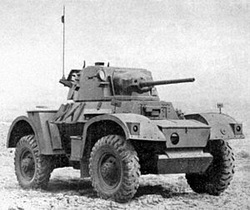
Daimler Armoured Car
The Daimler Armoured Car was a parallel development to the Daimler Dingo "Scout car", a small armoured vehicle for scouting and liaison roles. It was another Birmingham Small Arms design. A larger version designed upon the same layout as the Dingo fitted with the turret similar to that of the Mark VII Light Tank and a more powerful engine. Like the scout car, it incorporated some of the most advanced design concepts of the time and is considered one of the best British AFVs of the Second World War. The 95 hp engine was at the rear linked through a fluid flywheel to a Wilson preselector gearbox and then by propshafts to each wheel. Four wheel steering similar to early models of the Scout car was considered but not implemented following experience with the Dingo.
The prototypes had been produced in 1939, but problems with the transmission caused by the weight of the vehicle delayed service entry until mid-1941. 2,694 armoured cars were built by Daimler.
The Daimler had full independent suspension and four wheel drive. Epicyclic gearing in the wheel hubs enabled a very low ratio in bottom gear - it was credited with managing 1:2 inclines. The rugged nature combined with reliability made it ideal for reconnaissance and escort work.
Manufacturer Daimler
Number built 2,694
Weigh t7.6 t Length13 feet 1 inch (4 m) Width8 feet 1 inch (2.46 m) Height7 feet 5 inches (2.26 m)
Crew3
Armour7-16 mm
Main armament 2 pounder QF 52 rounds carried
Secondary armament 1 x coaxial 7.92 mm Besa machine gun 2,700 rounds carried 1 x 0.303 (7.7 mm) Bren light machine gun AA
EngineDaimler 27 4.1 litre 6-cylinder petrol95 hp (71 kW) Power/weight12.5 hp/tonne
Transmission 5 speed (both directions) with fluid flywheelSuspension4x4 wheel, independent coil spring.
Operational range 200 miles (320 km)
Speed50 miles per hour (80 km/h)
The Daimler Armoured Car was a parallel development to the Daimler Dingo "Scout car", a small armoured vehicle for scouting and liaison roles. It was another Birmingham Small Arms design. A larger version designed upon the same layout as the Dingo fitted with the turret similar to that of the Mark VII Light Tank and a more powerful engine. Like the scout car, it incorporated some of the most advanced design concepts of the time and is considered one of the best British AFVs of the Second World War. The 95 hp engine was at the rear linked through a fluid flywheel to a Wilson preselector gearbox and then by propshafts to each wheel. Four wheel steering similar to early models of the Scout car was considered but not implemented following experience with the Dingo.
The prototypes had been produced in 1939, but problems with the transmission caused by the weight of the vehicle delayed service entry until mid-1941. 2,694 armoured cars were built by Daimler.
The Daimler had full independent suspension and four wheel drive. Epicyclic gearing in the wheel hubs enabled a very low ratio in bottom gear - it was credited with managing 1:2 inclines. The rugged nature combined with reliability made it ideal for reconnaissance and escort work.
Manufacturer Daimler
Number built 2,694
Weigh t7.6 t Length13 feet 1 inch (4 m) Width8 feet 1 inch (2.46 m) Height7 feet 5 inches (2.26 m)
Crew3
Armour7-16 mm
Main armament 2 pounder QF 52 rounds carried
Secondary armament 1 x coaxial 7.92 mm Besa machine gun 2,700 rounds carried 1 x 0.303 (7.7 mm) Bren light machine gun AA
EngineDaimler 27 4.1 litre 6-cylinder petrol95 hp (71 kW) Power/weight12.5 hp/tonne
Transmission 5 speed (both directions) with fluid flywheelSuspension4x4 wheel, independent coil spring.
Operational range 200 miles (320 km)
Speed50 miles per hour (80 km/h)
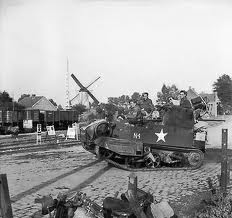
The Universal Carrier, also incorrectly known as the Bren Gun Carrier is a common name describing a family of light armoured tracked vehicles built by Vickers-Armstrong. Produced between 1934 and 1960, the vehicle was used widely by British Commonwealth forces during the Second World War. Universal Carriers were usually used for transporting personnel and equipment, mostly support weapons, or as machine gun platforms. With some 113,000 built in the United Kingdom and abroad, it is the most produced armoured fighting vehicle in history.
The origins of the Universal Carrier family can be traced back generally to the Carden Loyd tankettes family which was developed in the 1920s, and specifically the Mk VI tankette.
In 1934 Vickers Armstrong produced, as a commercial venture, a light tracked vehicle that could be used either to carry a machine gun or to tow a light field gun. The VA.D50 had an armoured box at the front for driver and a gunner and bench seating at the back for the gun crew. It was considered by the War Office as a possible replacement for their "Dragon" artillery tractors and took 69 as the "Light Dragon Mark III". One was built as the "Carrier, Machine-Gun Experimental (Armoured)" carrying a machine gun and its crew. The decision was made to drop the machine gun and its team and the next design had a crew of three – driver and gunner in the front, third crew-member on the left in the rear and the right rear open for stowage. A small number of this design as "Carrier, Machine-Gun No 1 Mark 1" were built and entered service in 1936. Some were converted into pilot models for the Machine gun Carrier, Cavalry Carrier and Scout Carrier – the others were used for training.
The carrier put the driver and commander at the front sitting side-by-side; the driver to the right. The engine was in the centre of the vehicle with the final drive at the rear. The suspension and running gear was based on that used on the Vickers light tank series using Horstmann springs Directional control was through a (vertical) steering wheel. Small turns moved the front road wheel assembly warping the track so the vehicle drifted to that side. Further movement of the wheel braked the appropriate track to give a turn.
The hull in front of the commander's position jutted forward to give room for the Bren gun (or other armament) to fire through a simple slit. To either side of the engine were two areas in which passengers could ride or stores be carried.
Initially, there were several types of Carrier that varied slightly in design according to their purpose: "Medium Machine Gun Carrier" (the Vickers machine gun), "Bren Gun Carrier", "Scout Carrier" and "Cavalry Carrier". However, production of a single model came to be preferred and the Universal design appeared in 1940; this was the most widely produced of the Carriers. It differed from the previous models in having a rectangular body shape in rear section, with more space for crew.
The Reconnaissance Corps regiments – which replaced the cavalry regiments in supporting Infantry divisions after 1940 – were each equipped with 63 carriers along with 28 Humber Scout cars.
Universal Carriers were issued to the support companies in infantry rifle battalions for carrying support weapons (initially 10, 21 by 1941, and up to 33 per battalion by 1943). A British armoured division of 1940–41 had 109 carriers in total; each motor battalion had 44.
Number built 113,000
Weight 3 ton 16 cwt laden
(3.75 t) Length12 ft (3.65 m) Width 6 ft 9 in (2.06 m) Height 5 ft 2 inch (1.57 m)
Crew3 Armour7–10 mm
Main armament Bren light machine gun or Boys anti-tank rifle
Secondary armament Vickers machine gun; M2 Browning machine gun; 2-inch mortar; 3-inch mortar; Projector, Infantry, Anti-Tank.
Engine Ford V8 petrol 85 hp at 3,500 rpm.
Suspension Horstmann
Operational range 150 miles (250 km).
Speed 30 mph (48 km/h)
The origins of the Universal Carrier family can be traced back generally to the Carden Loyd tankettes family which was developed in the 1920s, and specifically the Mk VI tankette.
In 1934 Vickers Armstrong produced, as a commercial venture, a light tracked vehicle that could be used either to carry a machine gun or to tow a light field gun. The VA.D50 had an armoured box at the front for driver and a gunner and bench seating at the back for the gun crew. It was considered by the War Office as a possible replacement for their "Dragon" artillery tractors and took 69 as the "Light Dragon Mark III". One was built as the "Carrier, Machine-Gun Experimental (Armoured)" carrying a machine gun and its crew. The decision was made to drop the machine gun and its team and the next design had a crew of three – driver and gunner in the front, third crew-member on the left in the rear and the right rear open for stowage. A small number of this design as "Carrier, Machine-Gun No 1 Mark 1" were built and entered service in 1936. Some were converted into pilot models for the Machine gun Carrier, Cavalry Carrier and Scout Carrier – the others were used for training.
The carrier put the driver and commander at the front sitting side-by-side; the driver to the right. The engine was in the centre of the vehicle with the final drive at the rear. The suspension and running gear was based on that used on the Vickers light tank series using Horstmann springs Directional control was through a (vertical) steering wheel. Small turns moved the front road wheel assembly warping the track so the vehicle drifted to that side. Further movement of the wheel braked the appropriate track to give a turn.
The hull in front of the commander's position jutted forward to give room for the Bren gun (or other armament) to fire through a simple slit. To either side of the engine were two areas in which passengers could ride or stores be carried.
Initially, there were several types of Carrier that varied slightly in design according to their purpose: "Medium Machine Gun Carrier" (the Vickers machine gun), "Bren Gun Carrier", "Scout Carrier" and "Cavalry Carrier". However, production of a single model came to be preferred and the Universal design appeared in 1940; this was the most widely produced of the Carriers. It differed from the previous models in having a rectangular body shape in rear section, with more space for crew.
The Reconnaissance Corps regiments – which replaced the cavalry regiments in supporting Infantry divisions after 1940 – were each equipped with 63 carriers along with 28 Humber Scout cars.
Universal Carriers were issued to the support companies in infantry rifle battalions for carrying support weapons (initially 10, 21 by 1941, and up to 33 per battalion by 1943). A British armoured division of 1940–41 had 109 carriers in total; each motor battalion had 44.
Number built 113,000
Weight 3 ton 16 cwt laden
(3.75 t) Length12 ft (3.65 m) Width 6 ft 9 in (2.06 m) Height 5 ft 2 inch (1.57 m)
Crew3 Armour7–10 mm
Main armament Bren light machine gun or Boys anti-tank rifle
Secondary armament Vickers machine gun; M2 Browning machine gun; 2-inch mortar; 3-inch mortar; Projector, Infantry, Anti-Tank.
Engine Ford V8 petrol 85 hp at 3,500 rpm.
Suspension Horstmann
Operational range 150 miles (250 km).
Speed 30 mph (48 km/h)
American Vehicles used by the Recce Corps
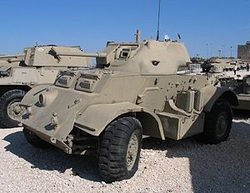
The T17 and the T17E1 were two American armored car designs produced during the Second World War. Neither saw service with frontline US forces but the latter was supplied, via the United Kingdom, to British and Commonwealth forces during the war and received the service name Staghound. A number of countries used the Staghound after the war, with some of the vehicles continuing to serve into the 1980s.
The British allocated the name Staghound to the T17E series. Production started in October 1942. Unlike the T17 when the US military decided to adopt the lighter M8 Greyhound vehicle, T17E1 production continued for the United Kingdom. Approximately 4,000 Staghounds were produced in total.
The Staghound was an innovative design that incorporated some advanced features. It had two rear-facing 6-cylinder engines with automatic transmissions (with 4 forward and 1 reverse gears) feeding through a transfer case to drive both axles. Either two- or four-wheel drive could be selected. Either engine could be shut down while in motion and taken out of the drive train. Additionally, a power steering pump was incorporated that could be switched on or off manually from the driver's instrument panel depending on steering conditions. Steering and suspension components were directly attached to the hull as the structure was rigid enough to dispense with the need for a separate chassis.
The Staghound entered service too late for use in the North African Campaign where its combination of armor, range and main armament would have been an advantage in a light forces reconnaissance role. As a result, it first saw operational service in Italy, where many units found its large physical size too restrictive in the narrow roads and streets of Europe. It saw most service at squadron and regimental headquarter level; an armoured car regiment having three Staghounds with the Regimental HQ and three with each HQ of the four squadrons in the regiment.
Designer Chevrolet
Number built 4,000
Weight 14 t Length17 ft 10 in (5.49 m) Width 8 ft 10 in (2.69 m) Height 7 ft 9 in (2.36 m)
Crew 5
Armour 9 to 44 mm
Main armament 37 mm M6
Secondary armament 2 or 3 x .30 (7.62 mm) machine guns
Engine2 x GMC 270 2 x 97 hp (72 kW) Power/weight 13.9 hp/tonne
Suspensionwheels, 4 x 4
Operational range 450 miles (724 km)
Speed 55 mph (89 km/h)
The British allocated the name Staghound to the T17E series. Production started in October 1942. Unlike the T17 when the US military decided to adopt the lighter M8 Greyhound vehicle, T17E1 production continued for the United Kingdom. Approximately 4,000 Staghounds were produced in total.
The Staghound was an innovative design that incorporated some advanced features. It had two rear-facing 6-cylinder engines with automatic transmissions (with 4 forward and 1 reverse gears) feeding through a transfer case to drive both axles. Either two- or four-wheel drive could be selected. Either engine could be shut down while in motion and taken out of the drive train. Additionally, a power steering pump was incorporated that could be switched on or off manually from the driver's instrument panel depending on steering conditions. Steering and suspension components were directly attached to the hull as the structure was rigid enough to dispense with the need for a separate chassis.
The Staghound entered service too late for use in the North African Campaign where its combination of armor, range and main armament would have been an advantage in a light forces reconnaissance role. As a result, it first saw operational service in Italy, where many units found its large physical size too restrictive in the narrow roads and streets of Europe. It saw most service at squadron and regimental headquarter level; an armoured car regiment having three Staghounds with the Regimental HQ and three with each HQ of the four squadrons in the regiment.
Designer Chevrolet
Number built 4,000
Weight 14 t Length17 ft 10 in (5.49 m) Width 8 ft 10 in (2.69 m) Height 7 ft 9 in (2.36 m)
Crew 5
Armour 9 to 44 mm
Main armament 37 mm M6
Secondary armament 2 or 3 x .30 (7.62 mm) machine guns
Engine2 x GMC 270 2 x 97 hp (72 kW) Power/weight 13.9 hp/tonne
Suspensionwheels, 4 x 4
Operational range 450 miles (724 km)
Speed 55 mph (89 km/h)
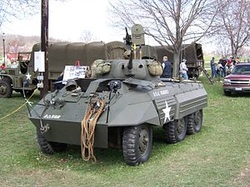
The M8 Light Armored Car was a 6x6 armored car produced by the Ford Motor Company during World War II. It was used by the United States and British troops in Europe and the Far East until the end of the war. The vehicle was widely exported and as of 2006 still remains in service with some third world countries.
In British service, the M8 was known as the Greyhound. The British Army found it too lightly armored, particularly the hull floor where anti-tank mines could easily penetrate (crews' solution was lining the floor of the crew compartment with sandbags). Nevertheless, it was produced in large numbers. The M8 Greyhound's excellent mobility made it a great supportive element in the advancing American and British armored columns.
The Cavalry Recon troop served as a division's or corps' advance "eyes and ears." This mission demanded speed and agility, not firepower and armor. When on the march, the Cavalry's mission was to make contact with enemy forces at the earliest practicable moment and maintain it thereafter. In this role, the recon troops identified hostile units and reported their strength, composition, disposition and movement. During withdrawals, the cavalry often served as a screening force for the main units.
The M8 performed this function with distinction. Each M8 armored car was equipped with a long-range radio set to assist in the exercise of command, or for the purpose of relaying information received from subordinate elements to higher headquarters. Another short-range radio set served to communicate within a Cavalry Reconnaissance platoon, reconnaissance team, or with headquarters. The M8 weighed 16,400 lb (7,400 kg) fully loaded with equipment and crew, and was capable of cruising 100–200 mi (160–320 km) cross country or 200–400 mi (320–640 km) on highways without refueling. On normal roads, it was capable of a sustained speed of 55 mph (89 km/h), hence its nickname.
The telescopic sight used to aim the main 37 mm gun
Unfortunately, the M8 was not designed for offensive combat, and its firepower was adequate only against similar lightly armored enemy vehicles and infantry. The vehicle's armor provided a fair degree of protection against small-arms fire but nothing more. Crews needed to survive by using speed and mobility to avoid hits instead of withstanding them. With a meager .12 in (3 mm) of floor armor, the M8 was particularly vulnerable to German mines.
The vehicle's other drawback was limited mobility in heavily wooded areas and on broken terrain, and armored Cavalry units preferred using the ¼-ton reconnaissance car (Jeep) in these environments. A large turning radius, limited wheel travel, open differentials, and limited cross-country mobility made the M8 armored car susceptible to immobilization off-road in off-camber terrain or defiles. This limited operators to using the vehicle mostly on existing roads or paths, where it became vulnerable to ambush. The lack of continuous tracks and poor tread contact area-to-weight ratio also hampered its off-road performance in mud, snow or alpine terrain and, in soft terrain, the M8 frequently sank to its axles. Conversely, performance on hard surfaces was exceptional. As a wheeled vehicle, the M8 was generally more reliable than tracked vehicles of similar size, and required far less maintenance and logistics support.
Weight 8.6 short tons (7.8 t) Length16 ft 4.8 in (5.00 m) Width8 ft 3.6 in (2.53 m) Height7 ft 4.8 in (2.26 m).
Crew4
Main armament 37 mm Gun M6
Secondary armament .30 and .50 machine guns
EngineHercules JXD 6-cyl gasoline 110 hp (82 kW) Power/weight14.1 hp/tonne
Suspension 6x6 wheel, leaf spring
Operational range 350 mi (560 km).
Speed 56 mph (90 km/h)
In British service, the M8 was known as the Greyhound. The British Army found it too lightly armored, particularly the hull floor where anti-tank mines could easily penetrate (crews' solution was lining the floor of the crew compartment with sandbags). Nevertheless, it was produced in large numbers. The M8 Greyhound's excellent mobility made it a great supportive element in the advancing American and British armored columns.
The Cavalry Recon troop served as a division's or corps' advance "eyes and ears." This mission demanded speed and agility, not firepower and armor. When on the march, the Cavalry's mission was to make contact with enemy forces at the earliest practicable moment and maintain it thereafter. In this role, the recon troops identified hostile units and reported their strength, composition, disposition and movement. During withdrawals, the cavalry often served as a screening force for the main units.
The M8 performed this function with distinction. Each M8 armored car was equipped with a long-range radio set to assist in the exercise of command, or for the purpose of relaying information received from subordinate elements to higher headquarters. Another short-range radio set served to communicate within a Cavalry Reconnaissance platoon, reconnaissance team, or with headquarters. The M8 weighed 16,400 lb (7,400 kg) fully loaded with equipment and crew, and was capable of cruising 100–200 mi (160–320 km) cross country or 200–400 mi (320–640 km) on highways without refueling. On normal roads, it was capable of a sustained speed of 55 mph (89 km/h), hence its nickname.
The telescopic sight used to aim the main 37 mm gun
Unfortunately, the M8 was not designed for offensive combat, and its firepower was adequate only against similar lightly armored enemy vehicles and infantry. The vehicle's armor provided a fair degree of protection against small-arms fire but nothing more. Crews needed to survive by using speed and mobility to avoid hits instead of withstanding them. With a meager .12 in (3 mm) of floor armor, the M8 was particularly vulnerable to German mines.
The vehicle's other drawback was limited mobility in heavily wooded areas and on broken terrain, and armored Cavalry units preferred using the ¼-ton reconnaissance car (Jeep) in these environments. A large turning radius, limited wheel travel, open differentials, and limited cross-country mobility made the M8 armored car susceptible to immobilization off-road in off-camber terrain or defiles. This limited operators to using the vehicle mostly on existing roads or paths, where it became vulnerable to ambush. The lack of continuous tracks and poor tread contact area-to-weight ratio also hampered its off-road performance in mud, snow or alpine terrain and, in soft terrain, the M8 frequently sank to its axles. Conversely, performance on hard surfaces was exceptional. As a wheeled vehicle, the M8 was generally more reliable than tracked vehicles of similar size, and required far less maintenance and logistics support.
Weight 8.6 short tons (7.8 t) Length16 ft 4.8 in (5.00 m) Width8 ft 3.6 in (2.53 m) Height7 ft 4.8 in (2.26 m).
Crew4
Main armament 37 mm Gun M6
Secondary armament .30 and .50 machine guns
EngineHercules JXD 6-cyl gasoline 110 hp (82 kW) Power/weight14.1 hp/tonne
Suspension 6x6 wheel, leaf spring
Operational range 350 mi (560 km).
Speed 56 mph (90 km/h)
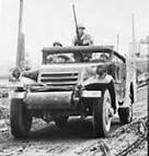
White Scout car
Design of the vehicle began at the White Motor Company, based in Cleveland, in 1937. It had .25 in (6.4 mm) face-hardened armour, full-time four-wheel drive (with no way to disengage it), four-speed manual constant-mesh (non-synchromesh) transmission (with one reverse gear) and two-speed transfer case, leaf spring suspension, manual steering, and (unusual for the period) vacuum-assisted (power) brakes. The wheelbase was 131 in (3.3 m), tread 65.25 in (1.657 m). The wheels were 8.5 in (220 mm) wide, 20 in (510 mm) diameter, and used standard 12-ply military non-directional tires. Fuel capacity was 30 US gal (110 l).
The original order was for 64 units, all of which were given to the 7th Cavalry Brigade. Eventually the Army decided to adopt an improved version, designated M3A1. The new version had a longer and wider hull. In front of the bumper an unditching roller was mounted. The M3A1 could carry up to seven infantry and provide fire support with three machine guns - one .50 caliber (12.7 mm) and two .30 caliber (7.62 mm) - mounted on a skate rail around the hull.
Production of the M3A1 started in 1940 and lasted until 1944, with 20,918 vehicles built.
The design influenced the later U.S. half-track designs such as the M3 half-track and the post-World War II Soviet BTR-40. The early M2 half-track copied the armour layout as well as the skate rail machine gun mount
Specifications
Weight 8,900 lb (4.0 t) Length 222 in (5.6 m) Width 80 in (2.0 m) Height 79 in (2.0 m)
Crew driver + 7
Armour 6–13 mm
Main Armament .50 cal M2 Browning machine gun
Secondary Armament .30 cal Browning M1919A4 machine gun
Engine Hercules JXD, 320 cu in (5,200 cc), L-head inline 6-cylinder, gasoline
110 hp (82 kW), compression ratio 6.5:1, Zenith Model 29 carburettor
Power/weight 19.4 hp/t
Suspension 4 x 4 wheel, leaf spring
Operational range 403 km
Speed 55 mph (89 km/h)
Design of the vehicle began at the White Motor Company, based in Cleveland, in 1937. It had .25 in (6.4 mm) face-hardened armour, full-time four-wheel drive (with no way to disengage it), four-speed manual constant-mesh (non-synchromesh) transmission (with one reverse gear) and two-speed transfer case, leaf spring suspension, manual steering, and (unusual for the period) vacuum-assisted (power) brakes. The wheelbase was 131 in (3.3 m), tread 65.25 in (1.657 m). The wheels were 8.5 in (220 mm) wide, 20 in (510 mm) diameter, and used standard 12-ply military non-directional tires. Fuel capacity was 30 US gal (110 l).
The original order was for 64 units, all of which were given to the 7th Cavalry Brigade. Eventually the Army decided to adopt an improved version, designated M3A1. The new version had a longer and wider hull. In front of the bumper an unditching roller was mounted. The M3A1 could carry up to seven infantry and provide fire support with three machine guns - one .50 caliber (12.7 mm) and two .30 caliber (7.62 mm) - mounted on a skate rail around the hull.
Production of the M3A1 started in 1940 and lasted until 1944, with 20,918 vehicles built.
The design influenced the later U.S. half-track designs such as the M3 half-track and the post-World War II Soviet BTR-40. The early M2 half-track copied the armour layout as well as the skate rail machine gun mount
Specifications
Weight 8,900 lb (4.0 t) Length 222 in (5.6 m) Width 80 in (2.0 m) Height 79 in (2.0 m)
Crew driver + 7
Armour 6–13 mm
Main Armament .50 cal M2 Browning machine gun
Secondary Armament .30 cal Browning M1919A4 machine gun
Engine Hercules JXD, 320 cu in (5,200 cc), L-head inline 6-cylinder, gasoline
110 hp (82 kW), compression ratio 6.5:1, Zenith Model 29 carburettor
Power/weight 19.4 hp/t
Suspension 4 x 4 wheel, leaf spring
Operational range 403 km
Speed 55 mph (89 km/h)
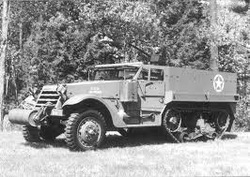
Half - Track
Between the world wars, the US Army sought to improve the tactical mobility of its forces. With the goal of finding a high-mobility infantry vehicle, the Ordnance Department had evaluated the half-track design by testing French Citroën-Kégresse vehicles. The White Motor Company produced a prototype half-track using their own chassis and the body of the M3 Scout Car.
The design, using as many commercial components as possible to improve reliability and rate of production, was standardised in 1940 and built by the Autocar Company, Diamond T Motor Company, and the White Company.
Offered with a choice of White 160AX or IHC RED DIAMOND 450 engines, the M3 was driven through a manual constant-mesh (non-synchromesh) transmission with four forward and one reverse gear, as well as a two-speed transfer case. Front suspension was leaf spring, tracks by vertical volute spring. Braking was vacuum-assisted hydraulic, steering manual, without power assist. The electrical system was 12-volt.
The M3 was the larger counterpart to the M2 Half-Track Car. The M2 was originally intended to function as an artillery tractor. The M3 had a longer body than the M2 with a single access door in the rear and seating for a 12-man rifle squad.[clarification needed] Ten seats were arranged down either side of the vehicle, with three in the cab. Racks under the seats were used for ammunition and rations; additional racks behind the seat backs held the squad’s rifles and other stowage. A small rack for mines was added on the outside of the hull just above the tracks. In combat, most units found it necessary to stow additional food, rucksacks and other crew stowage on the outside of the vehicle. Luggage racks were often added in the field, and very late vehicles had rear-mounted racks for this crew stowage.
Early vehicles had a pintle mount just behind the front seats mounting a .50-caliber (12.7 mm) M2 Browning machine gun. The later M3A1 adopted a raised, armoured 'pulpit mount' for the .50-caliber, and .30-caliber (7.62 mm) machine guns could be used from mounts along the sides of the passenger compartment. Many M3s were later modified to the M3A1 standard. The body was armoured all around, with an adjustable armoured shutter for the engine's radiator and a bullet-proof windscreen.
The half-tracks were initially extremely unpopular and dubbed "Purple Heart Boxes" (a grim reference to the US Army's decoration for combat wounds) by American troops. Chief complaints centered around the complete lack of overhead protection from airbursting artillery shells and that the armour was inadequate against machine gun fire.
Total production of the M3 ran to nearly 41,000 vehicles. To supply the Allied nations International Harvester produced several thousand of very similar vehicles, the M5 half-track for Lend-Lease.
Specifications Weight 9.3 t, Length 6.18 m, Width 2.22 m
Height 2.26 m, wheelbase 135.5 in (3,440 mm)
Crew 3 + 10 troops
Main armament 1 x 0.5 in (12.7 mm) M2 machine gun
Secondary armament 2 x 0.3 in (7.62 mm) M1919A4 machine guns
Engine White 160AX, 386 cu in (6,330 cc), 6 cylinder, petrol, compression ratio 6.3:1, 147 hp (110 kW)
Power/weight 15.8 hp/tonne
Suspension half track, vertical volute springs; front tread 64.5 in (1,640 mm) to 66.5 in (1,690 mm)
Fuel capacity 60 US gal (230 l)
Operational range 175 mi (282 km)
Speed 45 mph (72 km/h)
Between the world wars, the US Army sought to improve the tactical mobility of its forces. With the goal of finding a high-mobility infantry vehicle, the Ordnance Department had evaluated the half-track design by testing French Citroën-Kégresse vehicles. The White Motor Company produced a prototype half-track using their own chassis and the body of the M3 Scout Car.
The design, using as many commercial components as possible to improve reliability and rate of production, was standardised in 1940 and built by the Autocar Company, Diamond T Motor Company, and the White Company.
Offered with a choice of White 160AX or IHC RED DIAMOND 450 engines, the M3 was driven through a manual constant-mesh (non-synchromesh) transmission with four forward and one reverse gear, as well as a two-speed transfer case. Front suspension was leaf spring, tracks by vertical volute spring. Braking was vacuum-assisted hydraulic, steering manual, without power assist. The electrical system was 12-volt.
The M3 was the larger counterpart to the M2 Half-Track Car. The M2 was originally intended to function as an artillery tractor. The M3 had a longer body than the M2 with a single access door in the rear and seating for a 12-man rifle squad.[clarification needed] Ten seats were arranged down either side of the vehicle, with three in the cab. Racks under the seats were used for ammunition and rations; additional racks behind the seat backs held the squad’s rifles and other stowage. A small rack for mines was added on the outside of the hull just above the tracks. In combat, most units found it necessary to stow additional food, rucksacks and other crew stowage on the outside of the vehicle. Luggage racks were often added in the field, and very late vehicles had rear-mounted racks for this crew stowage.
Early vehicles had a pintle mount just behind the front seats mounting a .50-caliber (12.7 mm) M2 Browning machine gun. The later M3A1 adopted a raised, armoured 'pulpit mount' for the .50-caliber, and .30-caliber (7.62 mm) machine guns could be used from mounts along the sides of the passenger compartment. Many M3s were later modified to the M3A1 standard. The body was armoured all around, with an adjustable armoured shutter for the engine's radiator and a bullet-proof windscreen.
The half-tracks were initially extremely unpopular and dubbed "Purple Heart Boxes" (a grim reference to the US Army's decoration for combat wounds) by American troops. Chief complaints centered around the complete lack of overhead protection from airbursting artillery shells and that the armour was inadequate against machine gun fire.
Total production of the M3 ran to nearly 41,000 vehicles. To supply the Allied nations International Harvester produced several thousand of very similar vehicles, the M5 half-track for Lend-Lease.
Specifications Weight 9.3 t, Length 6.18 m, Width 2.22 m
Height 2.26 m, wheelbase 135.5 in (3,440 mm)
Crew 3 + 10 troops
Main armament 1 x 0.5 in (12.7 mm) M2 machine gun
Secondary armament 2 x 0.3 in (7.62 mm) M1919A4 machine guns
Engine White 160AX, 386 cu in (6,330 cc), 6 cylinder, petrol, compression ratio 6.3:1, 147 hp (110 kW)
Power/weight 15.8 hp/tonne
Suspension half track, vertical volute springs; front tread 64.5 in (1,640 mm) to 66.5 in (1,690 mm)
Fuel capacity 60 US gal (230 l)
Operational range 175 mi (282 km)
Speed 45 mph (72 km/h)
